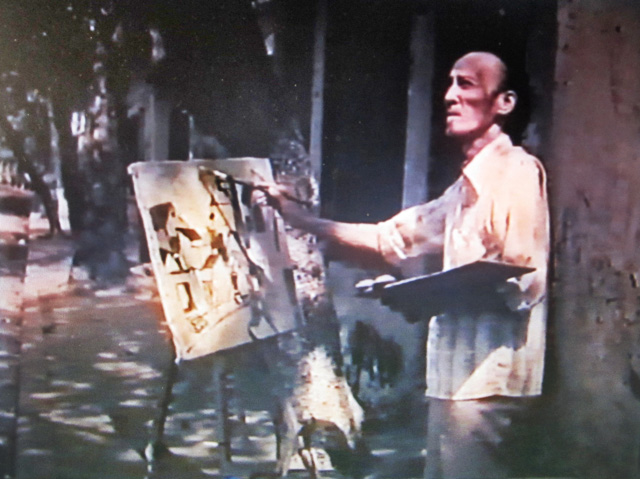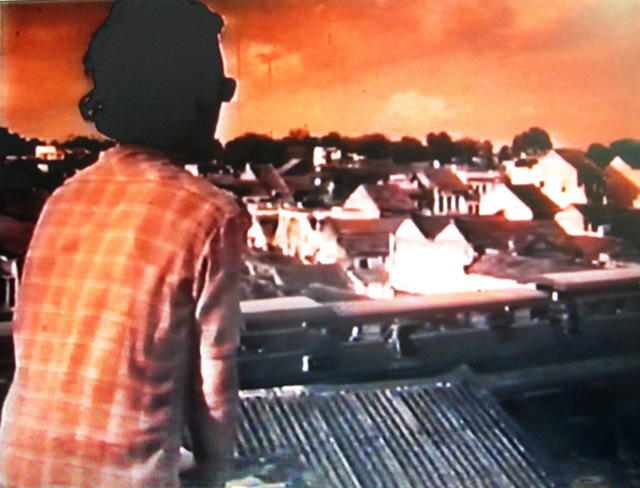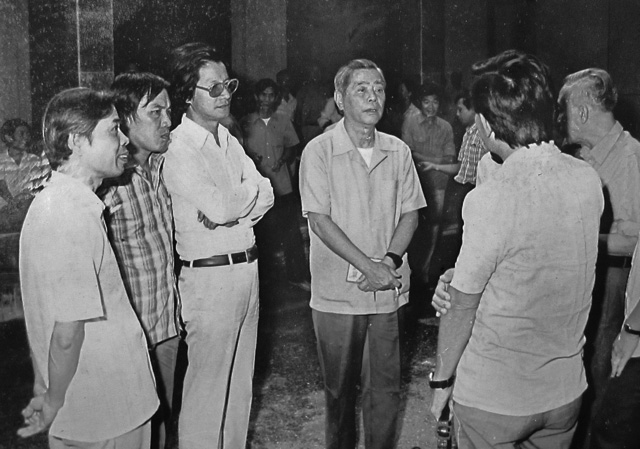Chapter Twelve
I should perhaps go back a bit, to mention some details concerning the making of this film.
From the time the montage was all complete, and until I began to add the soundtrack, I still didn’t know what name to give the film; I just knew that the title had to include the word “Hanoi.” I was totally baffled by this problem. Then, through some mysterious blessing conferred on me by Heaven and Earth, I one day picked up a copy of the paper Nhân Dân (“The People”)—a completely unconscious action, because I never read that publication—and started turning the pages. Page three had an article by a contemporary American writer (I completely forget the name) concerning Ernest Hemingway. I read it attentively because I like Hemingway and, when studying in Russia, I had moreover joined with some Cuban friends in making a film about Hemingway.
After finishing the article I found that it hadn’t left me with anything resembling Hemingway in my mind—I was irked. But when I looked again at the article’s title, I saw that the fellow who wrote it had, as it were, fished up a prize; the title was “Hemingway in My Eyes.”
How could you to argue with that? The views he presented were indeed “in his eyes.” But, like a flash of lightning, a thought occurred to me: This fellow has presented me with a most effective name…
I read the words in my head out loud, syllable by syllable: “Ha-noi-in-whose-eyes.” Hanoi in whose eyes? Hanoi in the eyes of the artist Bùi Xuân Phái, Hanoi in the eyes of the guitarist Văn Vượng; Hanoi in the eyes of Lý Thái Tổ when he wrote “The Proclamation on Moving the Capital”; Hanoi in the eyes of the Greek poet Ludemit; and on and on through the eyes of all the personages who have gazed at Hanoi and thought about the city. In fact, Hanoi could be in anyone’s eyes.

Hanoi in the eyes of the artist Bùi Xuân Phái.

And in the eyes of the guitarist Văn Vượng..
The prize I had snagged was without a doubt greater than the author’s. I had stolen an idea, to be sure, but that idea was a treasure! And I should add something about the word “ai” (who, whose). The word has many meanings; it is not just a pronoun applied to people, like “qui,” “wer,” “кто…” in other languages, but can also make one think of sorrow, resentment, tragedy…
These days, when I respond to questions posed by interviewers, or questions asked me after I give talks, I say what I actually feel deep in my bones: that I’m not at all enthusiastic about recalling the period when I made the film Hanoi in Whose Eyes, nor do I want to watch the film again and recount the sad old stories of honor and disgrace that developed afterward.
There are many reasons for this.
- Everyone knows the stories relating to this film; to go on repeating them would become tiresome.
- Thirty years have passed already—when I look back at this film, I feel embarrassed from the standpoint of art, technique, and method—it leaves no impression worth mentioning; it consists simply of unadorned scenes joined together, which are guided along by words full of implications
- The film was shot using 35-millimeter ORWO color film; the colors are faded and streaky; there are no copies left that meet good technical standards.
- The conclusion of the film was revised in a foolish manner; back then, when I could have been arrested at any moment, I had to add a scene at the end showing Ba Đình Square on a day when a celebration was going on. The appearance of that scene in the movie was totally beyond my wishes.
- And, above all, when I made Hanoi in Whose Eyes thirty years ago, society, though it had many things wrong with it, was not as depraved as it has now become.
I wish to add that this film became famous, not because it showed great intellect or talent, but because it generated controversy that went on for a long time. People jostled each other and stood in lines to buy tickets because it was banned—it had been placed on the chopping board, had been classified as politically problematic, as anti-party. It sought to educate those in power, it called upon people to go down into the streets; some kind of political force lurked behind the director’s back… In short it became famous due to the excessive suspiciousness and diligence of a number of people who were then in power.
And so, a number of years later, on December 15 1986, the Sixth National Congress of the Vietnamese Communist Party opened, and Mr. Nguyễn Văn Linh was elected general secretary. This was an immensely important party congress; it inaugurated policy of renovation (đổi mới) and promulgated a number of new slogans:
“Look straight at the truth, reflect the truth, and evaluate things according to the truth.”
“Untie the bonds of writers and artists.”
“Let writers and artists save themselves before they are saved by Heaven.”
“Don’t bend your pen; you must write the things you think.”
Many scholars thought that these slogans were very revolutionary in the context of Vietnam at that time, but in the context of humanity taken as a whole, they were as old as the hills. How ironic—that just speaking the truth should be regarded as “revolutionary!” And it was a mere beginning; heaven only knew how long it would last…
The renovation policy would require a revision of all the problem-areas of Vietnamese society, including social science, literature, and the arts (factors not of great weight compared with internal and external matters, and with the problem of developing the economy).
One resolution that was immensely important for artists and intellectuals at that time was Resolution 05 of the Central Committee of the Vietnamese Communist Party with regard to the leadership and administration of culture and art. The content of this resolution concerned the reformulation and reorganization of procedures used to administer the arts.
All resolutions up to that point had merely specified what people must do, or what party members must do; there had never been a resolution saying what the party leadership must do to correct itself. Trần Độ was at that time the right hand man of general secretary Nguyễn Văn Linh. He was the one who drafted that resolution.
In May 1987 Mr. Nguyễn Văn Linh saw the film Hanoi in Whose Eyes with his own eyes. In view of the rumors concerning the film that had flown about for so long, he was utterly taken aback when he saw it.
He turned to us, and in all sincerity asked, “Is this really all the film amounts to, gentlemen?”
“Yes, there’s nothing more to the film than this.”
“If that’s all it amounts to, then why was it prohibited? Or is it because my knowledge is so limited that I can’t understand it?”
I was deeply moved by these simple words and was haunted by them for a long time thereafter. After that, he had a showing organized for Hanoi In Whose Eyes” in the Nguyễn Cảnh Chân Meeting Hall (located in the compound of the Central Party Committee), and invited people in high positions, and literary and artistic leaders, and chiefs of literary and artistic associations to come and cast votes approving or disapproving of the film.
The viewers all cast approving votes, which meant that the film would be shown to the general public.
On September 26, 1987, the office of the Central Committee of the Party issued a directive requesting the Department of Culture and Art, the the Department of Propaganda and Training, and the Ministry of Culture to organize public showings of the film Hanoi In Whose Eyes.
On October 7 and 8 of 1987, Mr. Nguyễn Văn Linh organized a great conference with more than two hundred writers, artists and intellectuals at the Nguyễn Cảnh Chân Meeting Hall. In his opening remarks, he said, “Comrades, I have invited you all here today so that you may bare your feelings and allow others to hear all your concerns, all your troubled thoughts concerning our cultural and artistic policies and measures, so that we may can work better with each other. I have come here to listen, not to speak…”
He then sat down and began to listen to everyone speak. Back then there were still such major figures as Nguyễn Khắc Viện, Cù Huy Cận, and Nguyễn Đình Thi… all the prominent writers, researchers and intellectuals of the North were there.
On the first day of the conference (October 7, 1987), a bell rang announcing a break, and everyone went out to the courtyard. I was talking with the writer Nguyễn Khải. In The Story of Kindness, I had quoted some words of his without revealing that they were his. In the stretch of film before it shifts to the scene in which a teacher is selling vegetables amid a tightly packed crowd, one hears: “A writer once wrote that man is a creature that will never consent to live with his arms crossed, but always reaches toward the superlative, the infinite, the eternal—all the goals that remain forever beyond his reach. At that time, The Story of Kindness couldn’t yet be publically shown, so I was just whispering a few words of thanks to Nguyễn Khải.
Lưu Quang Vũ came up to me and said, “Mr. Nguyễn Văn Linh told me to call you over for a little talk.”

“Now I’ve come to understand why people prohibited that film.” Starting from the left: Nguyễn Văn Hạnh, Lưu Quang Vũ, Trần Văn Thủy, Nguyễn Văn Linh, an unidentified person, and Trần Độ.
I went out to meet him and stood in a group photograph that included Nguyễn Văn Linh, Trần Độ, Lưu Quang Vũ, and Nguyễn Văn Hạnh. Mr. Nguyễn Văn Linh said to me, “Now I’ve come to understand why they banned that film.”
One could see from this how deeply this matter obsessed him—it had been back in May 1987 when he saw Hanoi In Whose Eyes! He said, “I suggest that you make a sequel, a “Part 2.”
When I heard him say this, I knew at once what I must do. At that time, The Story of Kindness had been finished, but it was just sitting there, because Hanoi In Whose Eyes was still banned. There was no way to promote the film or to get it approved by the board of censors, so it could be distributed and shown. It was a pipe dream. But now, an opportunity had come!
As soon as the conference was over, I returned to the studio and met with the designer Trịnh Quang Vũ, asking him to add the words “Part 2” underneath the title “The Story of Kindness,” indicating that this was part two of Hanoi In Whose Eyes, made at the instruction of the general secretary. I was very conscious this was not the right thing to do with regard to Mr. Nguyễn Văn Linh, but circumstances left me with no choice but to behave in this way. It seemed to me that holding the reins of power and directing the weighty affairs of the nation was the business of our superiors and that how to make films was our own business. Thus thanks to the path opened by Mr. Linh, The Story of Kindness came into the world, survived, and found its way into every corner of the world.
Order In Whose Eyes from the University of Massachusetts Press, or from Amazon.
All text and images are © 2023, Trần Văn Thủy, all rights reserved. Written permission is required for any use.